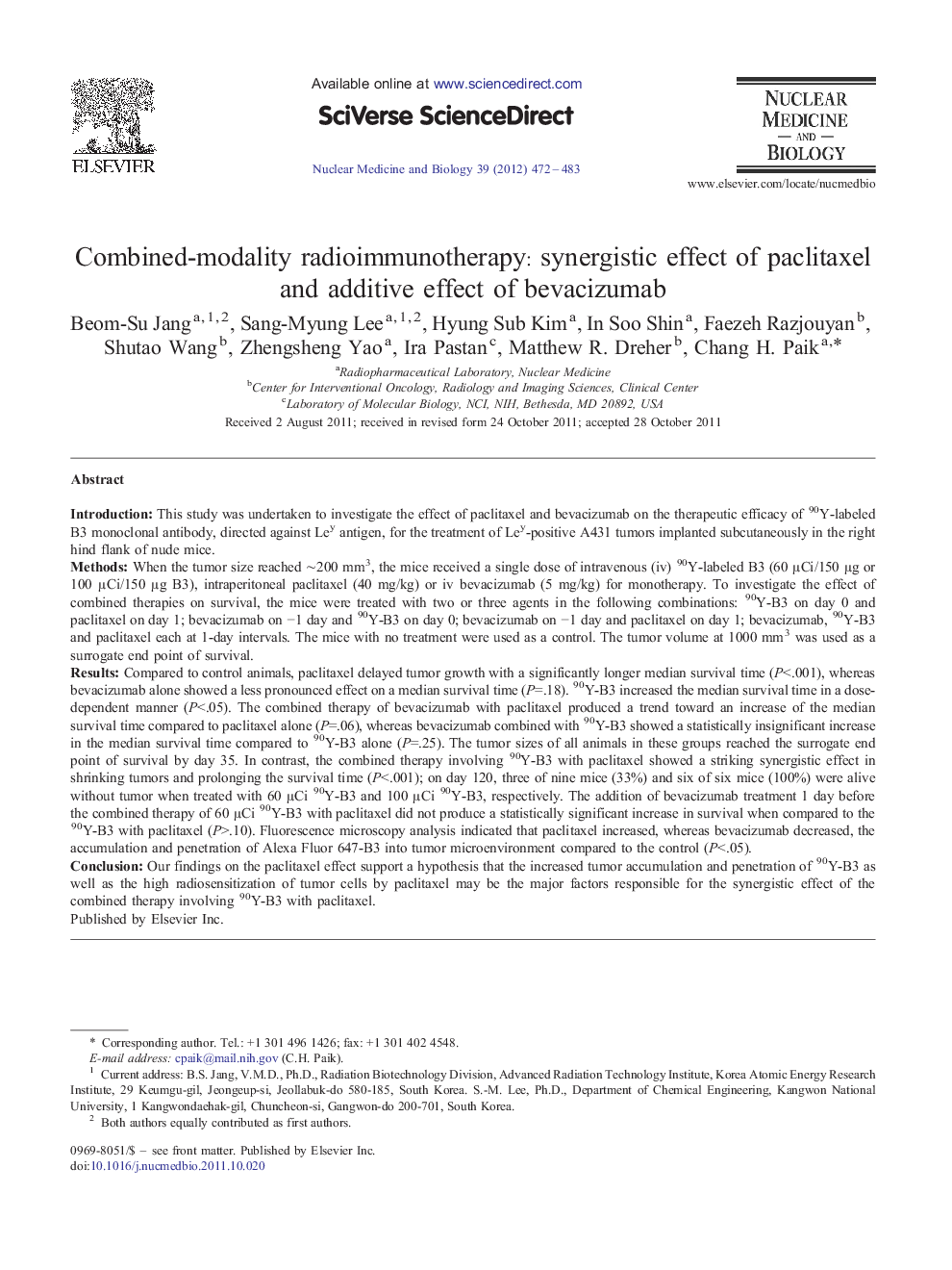| کد مقاله | کد نشریه | سال انتشار | مقاله انگلیسی | نسخه تمام متن |
|---|---|---|---|---|
| 2154138 | 1090219 | 2012 | 12 صفحه PDF | دانلود رایگان |

IntroductionThis study was undertaken to investigate the effect of paclitaxel and bevacizumab on the therapeutic efficacy of 90Y-labeled B3 monoclonal antibody, directed against Ley antigen, for the treatment of Ley-positive A431 tumors implanted subcutaneously in the right hind flank of nude mice.MethodsWhen the tumor size reached ∼200 mm3, the mice received a single dose of intravenous (iv) 90Y-labeled B3 (60 μCi/150 μg or 100 μCi/150 μg B3), intraperitoneal paclitaxel (40 mg/kg) or iv bevacizumab (5 mg/kg) for monotherapy. To investigate the effect of combined therapies on survival, the mice were treated with two or three agents in the following combinations: 90Y-B3 on day 0 and paclitaxel on day 1; bevacizumab on −1 day and 90Y-B3 on day 0; bevacizumab on −1 day and paclitaxel on day 1; bevacizumab, 90Y-B3 and paclitaxel each at 1-day intervals. The mice with no treatment were used as a control. The tumor volume at 1000 mm3 was used as a surrogate end point of survival.ResultsCompared to control animals, paclitaxel delayed tumor growth with a significantly longer median survival time (P<.001), whereas bevacizumab alone showed a less pronounced effect on a median survival time (P=.18). 90Y-B3 increased the median survival time in a dose-dependent manner (P<.05). The combined therapy of bevacizumab with paclitaxel produced a trend toward an increase of the median survival time compared to paclitaxel alone (P=.06), whereas bevacizumab combined with 90Y-B3 showed a statistically insignificant increase in the median survival time compared to 90Y-B3 alone (P=.25). The tumor sizes of all animals in these groups reached the surrogate end point of survival by day 35. In contrast, the combined therapy involving 90Y-B3 with paclitaxel showed a striking synergistic effect in shrinking tumors and prolonging the survival time (P<.001); on day 120, three of nine mice (33%) and six of six mice (100%) were alive without tumor when treated with 60 μCi 90Y-B3 and 100 μCi 90Y-B3, respectively. The addition of bevacizumab treatment 1 day before the combined therapy of 60 μCi 90Y-B3 with paclitaxel did not produce a statistically significant increase in survival when compared to the 90Y-B3 with paclitaxel (P>.10). Fluorescence microscopy analysis indicated that paclitaxel increased, whereas bevacizumab decreased, the accumulation and penetration of Alexa Fluor 647-B3 into tumor microenvironment compared to the control (P<.05).ConclusionOur findings on the paclitaxel effect support a hypothesis that the increased tumor accumulation and penetration of 90Y-B3 as well as the high radiosensitization of tumor cells by paclitaxel may be the major factors responsible for the synergistic effect of the combined therapy involving 90Y-B3 with paclitaxel.
Journal: Nuclear Medicine and Biology - Volume 39, Issue 4, May 2012, Pages 472–483